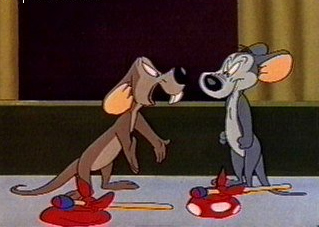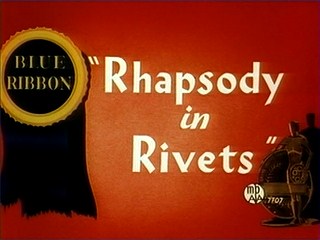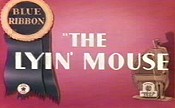
Looney Tunes is an American animated franchise produced and distributed by Warner Bros. It began as a series of short films that originally ran from 1930 to 1969, concurrently with its partner series Merrie Melodies, during the golden age of American animation. Following a revival in the late 1970s, new shorts were released as recently as 2014. The two series introduced a large cast of characters, including Bugs Bunny, Daffy Duck, and Porky Pig. The term Looney Tunes has since been expanded to also refer to the characters themselves.

Hubie and Bertie are animated cartoon rodent characters in the Warner Bros. Looney Tunes and Merrie Melodies series of cartoons. Hubie and Bertie represent some of animator Chuck Jones' earliest work that was intended to be funny rather than cute. Seven Hubie and Bertie cartoons were produced between 1943 and 1952.

Rhapsody Rabbit is a 1946 American animated comedy short film in the Merrie Melodies series, directed by Friz Freleng and featuring Bugs Bunny. The movie was originally released to theaters by Warner Bros. Pictures on November 9, 1946. This short is a follow-up of sorts to Freleng's 1941 Academy Award-nominated Rhapsody in Rivets, which featured the "Hungarian Rhapsody No. 2" by Franz Liszt. The "instrument" used to perform the "Hungarian Rhapsody" in Rhapsody in Rivets is a skyscraper under construction, while this short features Bugs playing the piece at a piano while being pestered by a mouse.

Mouse Menace is a 1946 Warner Bros. Looney Tunes animated short film directed by Arthur Davis. The short was released on November 2, 1946, and stars Porky Pig.

Tweetie Pie is a 1947 Warner Bros. Merrie Melodies cartoon directed by Friz Freleng. The short was released on May 3, 1947, and stars Tweety with Sylvester, who is called "Thomas" in this cartoon.

Dough for the Do-Do is a 1949 Warner Bros. Merrie Melodies cartoon directed by Friz Freleng. The short was released on September 2, 1949, and stars Porky Pig. The short is a remake of Bob Clampett's 1938 cartoon Porky in Wackyland, as well as using footage from his 1943 cartoon Tin Pan Alley Cats.

The Looney Looney Looney Bugs Bunny Movie is a 1981 American animated comedy package film with a compilation of classic Looney Tunes/Merrie Melodies Warner Bros. cartoon shorts and animated bridging sequences produced and directed by Friz Freleng, hosted by Bugs Bunny. The new footage was produced by Warner Bros. Animation. It was the first Looney Tunes/Merrie Melodies film with a compilation of classic cartoon comedy shorts produced by Warner Bros. Animation.

Snow Business is a 1953 Warner Bros. Looney Tunes cartoon directed by Friz Freleng. The short was released on January 17, 1953, and stars Tweety and Sylvester. The title is a pun on "Show Business".

Cheese Chasers is a 1951 Warner Bros. Cartoons Merrie Melodies cartoon directed by Chuck Jones and written by Michael Maltese. The cartoon was released on August 25, 1951 and stars Hubie and Bertie, with Claude Cat.
The Fella with a Fiddle is a 1937 Warner Bros. Merrie Melodies cartoon directed by Friz Freleng. The short was released on March 27, 1937.
Tweety's Circus is a 1955 Warner Bros. Merrie Melodies cartoon short directed by Friz Freleng. The short was released on June 4, 1955, and stars Tweety and Sylvester.
This is a listing of all the animated shorts released by Warner Bros. under the Looney Tunes and Merrie Melodies banners between 1960 and 1969. A total of 147 shorts were released during the 1960s.
It's Nice to Have a Mouse Around the House is a 1965 Warner Bros. Looney Tunes cartoon animated short directed by Friz Freleng. The short was released on January 16, 1965, and stars Daffy Duck, Speedy Gonzales, Sylvester and Granny. The voices were performed by Mel Blanc and Ge Ge Pearson.
Greedy for Tweety is a 1957 Warner Bros. Looney Tunes cartoon directed by Friz Freleng. The short was released on September 28, 1957, and stars Tweety and Sylvester.
The Cat Came Back is a 1936 Warner Bros. Merrie Melodies cartoon directed by Friz Freleng. The short was released on February 8, 1936.
Little Red Rodent Hood is a 1952 Warner Bros. Merrie Melodies animated short directed by Friz Freleng. The short was released on May 3, 1952, and stars Sylvester in a spoof of "Little Red Riding Hood".

Rhapsody in Rivets is a 1941 Warner Bros. Merrie Melodies cartoon directed by Friz Freleng. The short was released on December 6, 1941.

The Fifth-Column Mouse is a 1943 Warner Bros. Merrie Melodies animated cartoon directed by Friz Freleng. The short was released on March 6, 1943.
The Miller's Daughter is a 1934 Warner Bros. Merrie Melodies cartoon directed by Friz Freleng. The short was released on October 13, 1934.

Mouse and Garden is a 1960 Warner Bros. Looney Tunes cartoon directed by Friz Freleng. The Academy Award-nominated cartoon was released on July 16, 1960, and stars Sylvester.












